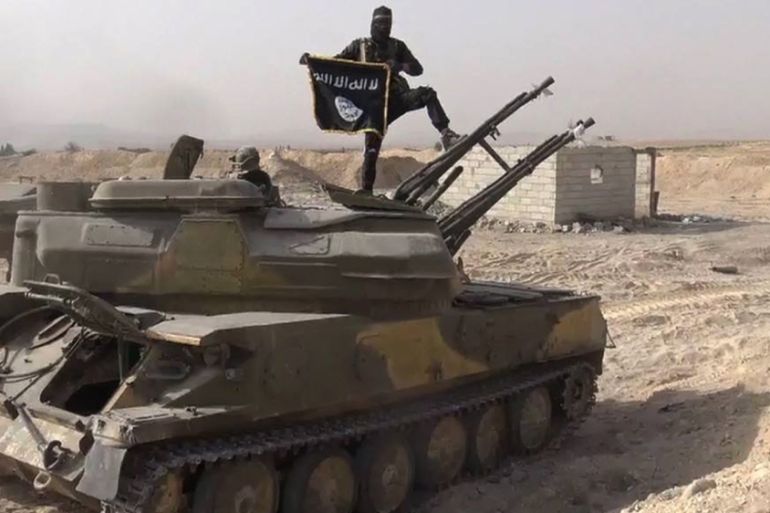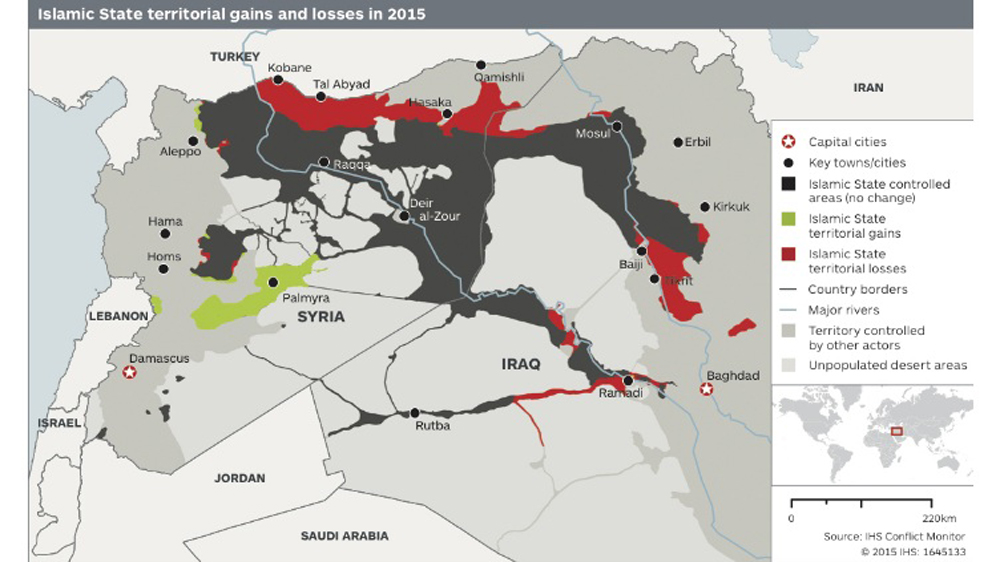ISIL ‘caliphate’ shrank by 14 percent in 2015: monitor
Armed group lost large swaths of Syria’s border with Turkey, as Kurds regained control of traditionally Kurdish areas.

The Islamic State of Iraq and the Levant (ISIL) has lost about 14 percent of its territory in 2015, while Syria’s Kurds have almost tripled theirs, think-tank IHS Jane’s has said.
The development will be seen as a blow to the group given its stated aim to capture and hold territory to expand its so-called “caliphate”, where it imposes its version of Islamic law.
The losses of ISIL include the strategically important town of Tal Abyad on Syria’s border with Turkey, the Iraqi city of Tikrit, and Iraq’s Baiji refinery.
Other big losses for the group include a stretch of highway between its Syrian stronghold Raqqa and Mosul in northern Iraq, complicating supply lines.

IHS Jane’s said the group’s territory had shrunk 12,800 square kilometres to 78,000 square kilometres between the start of the year and December 14.
“We had already seen a negative financial impact on the Islamic State [ISIL] due to the loss of control of the Tal Abyad border crossing prior to the recent intensification of air strikes against the group’s oil production capacity,” said Columb Strack, senior Middle East analyst with the US think-tank.
However, ISIL has made some high-profile gains during the year, including the historic Syrian town of Palmyra and the city centre of Ramadi, the provincial capital of Anbar, Iraq’s largest province.
![In August 2015 ISIL blew up the 2,000-year-old temple of Baalshamin in Syria's ancient caravan city of Palmyra [AP]ISIL has also destroyed part of the Monumental Arch in the historical city of Palmyra [Reuters]](/wp-content/uploads/2015/09/a6e45a4e2521470a809f871c2248b213_18.jpeg)
IHS Jane’s said those victories came at the expense of the group’s northern territories, which have been fiercely contested by Kurdish fighters.
Land under Syrian Kurdish control jumped 186 percent over the year, the intelligence review said.
“This indicates that the Islamic State [ISIL] was overstretched, and also that holding Kurdish territory is considered to be of lesser importance than expelling the Syrian and Iraqi governments from traditionally Sunni lands,” Strack said.
“The Kurds appear to be primarily an obstruction to the Islamic State, rather than an objective in themselves.”
Syrian Kurdish fighters dominate a group called the Syrian Democratic Forces, a coalition of Kurdish and Arab fighters battling ISIL in northeastern Syria, that has grown in prominence in recent months.
![Lands under Syrian Kurdish control jumped 186 percent over the year, IHS Jane's said [Reuters]
The Democratic Forces of Syria, in November, captured the town of al-Houl in Hasakah province, which had been held by ISIL [Reuters]](/wp-content/uploads/2015/12/7f8e1d028ebc42ff8e338f499127a656_18.jpeg)
The Democratic Forces of Syria, in November, captured the town of al-Houl in Hasakah province, which had been held by ISIL [Reuters]
ISIL has also been targeted by US-led coalition air strikes, Iraqi forces and Syrian rebels.
Iraq’s government managed to claw back some six percent of its territory from ISIL in the past year, IHS Jane’s said, while Iraqi Kurds regained two percent of their lands.
The biggest territorial loser among the main factions in the Syrian conflict was the Syrian government, which lost 16 percent and is now left with around 30,000 square kilometres, according to the think-tank, less than half the area controlled by ISIL and a fraction of Syria’s total area of about 185,000 square kilometres.
![Troops loyal to President Bashar al-Assad lost 16 percent of its territory, according to IHS Jane's [Reuters]](/wp-content/uploads/2015/02/b5cba02e93834f39b64a247a606cc533_18.jpeg)